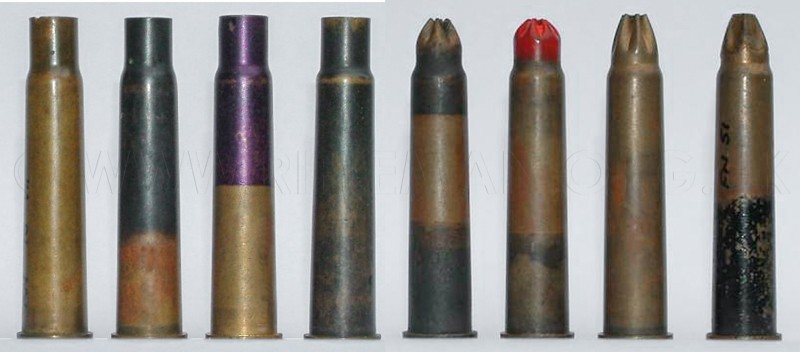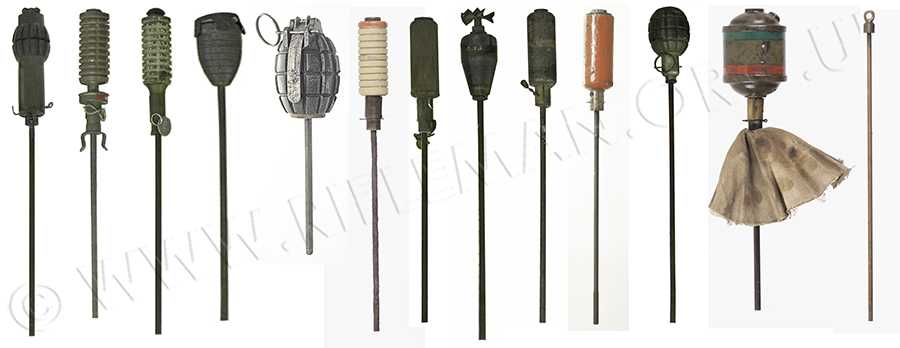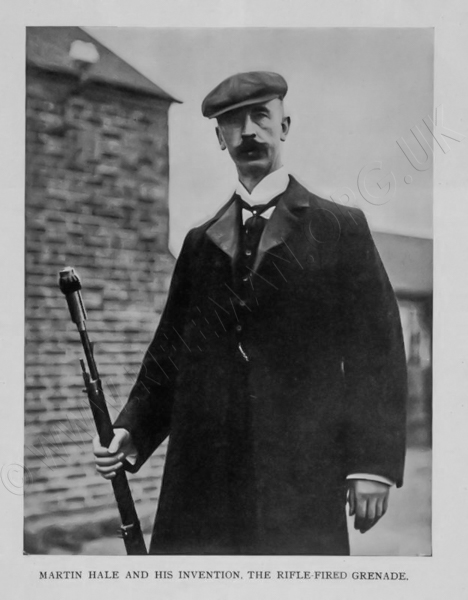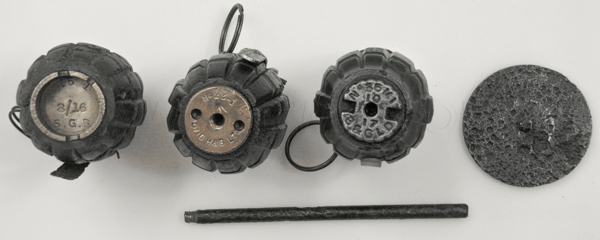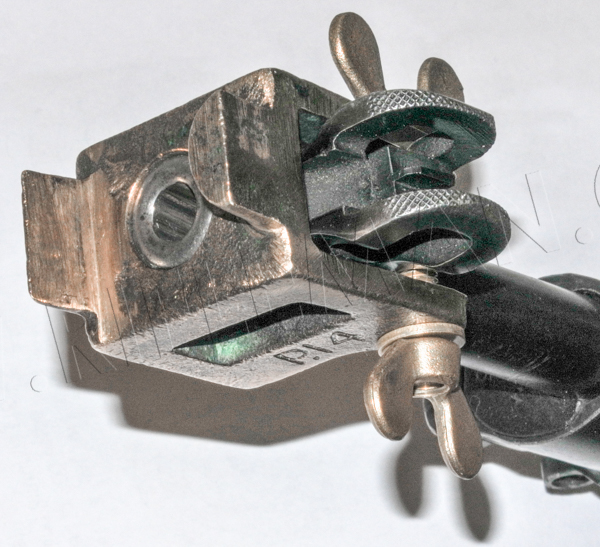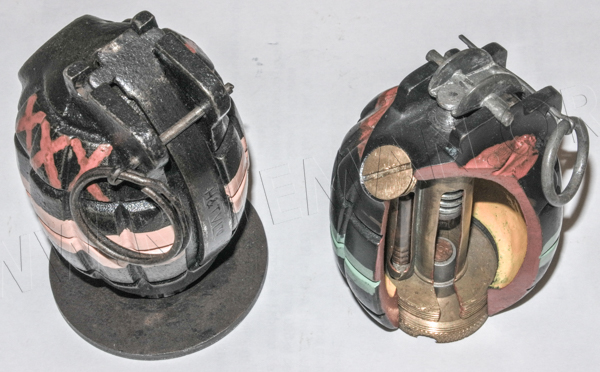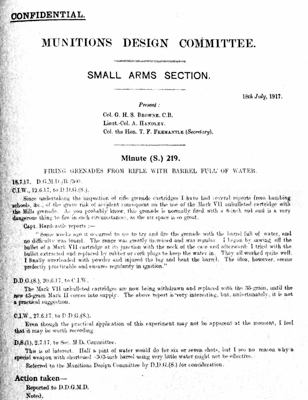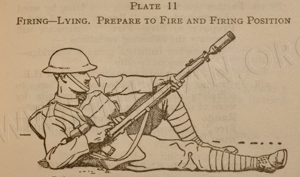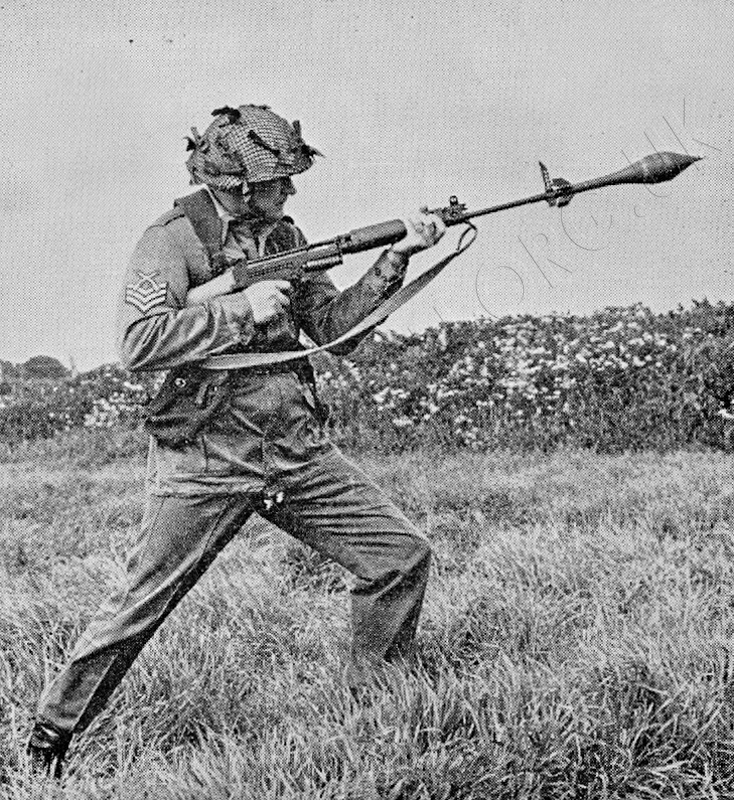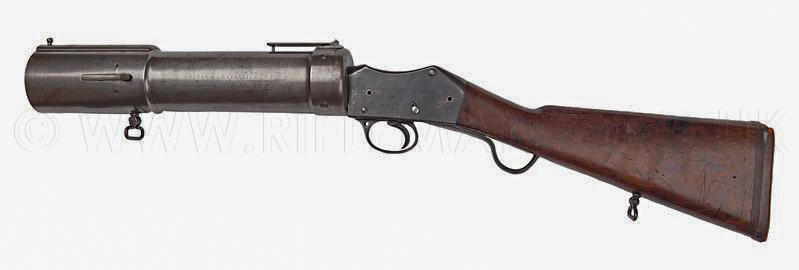Lee-Enfield Rifle Grenades & Launchers
For more on these rifles, see The Rifle. Short, Magazine Lee-Enfield, (S.M.L.E.), plus
Instructions on Bombing (Grenades) - 1917
Grenades are far from being a Twentieth Century invention,
having been brought into use as hand thrown weapons from as far back as the Fifteenth Century.
Rifle grenades did exist in the latter part of the Nineteenth Century, although quite rare,
but were available in British armouries for use with cup dischargers fitted to flintlock muskets.
The commonplace employment of rifle grenades was inevitable
with the advanced mechanisation of weaponry at the commencement of the First World War.
The Small Arms School collection at Warminster
carries a display of British Forces service rifles,
starting in the early 1900s, with their grenade projection devices.
This page illustrates some of the more common examples of the Twentieth Century.
Lee-Enfield No.1 Mk.III* with No.35 rodded grenade (1917).
Lee-Enfield No.1 Mk.III* with No.1 Mk.1 Grenade discharger (1916).
Lee-Enfield No.1 Mk.III* with Burns' 2½-inch Discharger Cup (1917)
Lee-Enfield No.1 Mk.III with discharger cup, 2-inch No.1 Mk.I (1925)
German Mauser Gewehr 98 with discharger
Lee-Enfield No.4 with No.5 projector and Energa grenade
L1A1 SLR with later grenade and projector
AR15 (USA) used by British special forces, with grenade
Enfield L85A1/SA80 with Practice Grenade L86A1
Image by courtesy of the C.O. of the S.A.S.C.
Commencing with the two rifles at the top of the SASC display,
the "Short" Lee-Enfield rifle, which superceded the "Long" Lee-Enfield in 1903,
was a prime means of sending hand grenades into the enemy trenches during the First World War.
Below is a 1905 Lee-Enfield No.I Mark I fitted with the No.1 Mark I grenade cup for the No.23 Mills grenade,
held in place on the rifle's nosecap by the 1907 quillon bayonet.
The nomenclature described the discharger as a cup, but it was really only a pressed steel component ring band.
The grenade shown is the No.23 Mills model, the rifle adaptation of the original No.5.
These early S.M.L.E. rifles were still in use early in the Great War,
prior to the issue of the No.I Mark III rifles that formed
the mainstay of the Lee-Enfields through WWI and beyond.
The image can be rotated and zoomed, either as initially loaded or full-screen for higher definition.
Slide cursor < > to rotate, and Click to zoom.
Prior to the very first issue of the Mills bomb in May 1915, there were a number of hand grenade designs in use during the early months of the First World War. The need to project grenades, further than was possible by hand, was filled by various designs of grenade heads with rods attached that fitted into the bore of the .303 inch calibre Enfield rifles.
These grenades were launched from the muzzle of the rifle using a cartridge that produced only gas pressure in the barrel. Using a live bulleted cartridge by mistake would result in serious injury, or worse, to the firer and those around him. The early grenade firing cartridges were plain cartridge cases filled with propellant powder and plugged with a hard wax-like compound. Later cartridges were of the more usual crimped neck type, familiar to the many who have been involved in military exercises over the years. The cases of both periods were usually part dipped in a coloured stain to identify their type and purpose.
All WWI grenade discharging cartridges had open necks, but WW2 issue used the rosette crimped .303 flanged cases familiar to all those who have experienced military exercises up to the time the NATO 7.62mm round was introduced in the mid 1950s for the transitional Lee-Enfield rifles and the L1A1 FN SLR (Self Loading Rifle).
Note that, in British military nomenclature, blanks are all just "cartridges", while bulleted cartridges are "rounds".
In 2012, the late Tony Edwards, a noted authority on British Smallarms Ammunition who assisted with a number of subjects covered by this website, wrote as follows on the War Relics forum in answer to a member's query about grenade firing and training blank cartridges:
"There is a world of difference between training blanks and Grenade discharging blanks. It is all to do with the burning rate of the powder. If you tried to launch a grenade with a training blank it would probably blow up the rifle.
The "E" in the headstamps is the code for Eley Brothers and the cases are made from reject Mark VII ball cases as has already been pointed out. That "E" is nothing to do with the "E" in "E Mark IT", where the "E" is the code for a smoke generator discharger from armoured vehicles and the "T" indicates it is loaded with Black powder. The E Mark IT was only used for a very short period in the 1930s and no example with that headstamp is known to survive today.
Although the very early grenade discharging blanks in WWI were simply Ball rounds with the bullet removed, specialist rounds were soon developed for firing different grenades. The rounds with the top half blackened are the "Cartridge S.A. .303 inch Rifle Grenade 30 Grains Ballistite Mark I" wihich changed in 1927 to "... .303 inch H Mark Iz" and was used for launching No.23 and other grenades form the cup discharger. Rounds with the whole case blackened are for rodded grenades and became the H Mark II after the 1927 changes in nomenclature.
The range of rifle projected greandes was considerable, ranges of 300 yards being obtained depending on the grenade.Moving on from the H Mark I and II I described in my previous post, the H Mark III was an Indian version of the H Mark I, but loaded with cordite as this was more stable in tropical climes.
The H Mark IV (and IVz) is a bit more complicated. The British H Mk.4 (post 1944 the Roman Mark numbers were changed to Indo-arabic) was a British made blank for launching the No.85 Grenade from the No.5 rifle. However, the Australians also introduced a H Mark 4 for launching the grenade from No.1 and No.4 rifles and so had a heavier charge of cordite. Both the British and Australian versions were closed with a rosette crimp and often had a red closing seal.
The H Mark 5 was an Indian and Pakistani cordite loaded version of the H Mark 4 and also had the red closure. Then there was an Indian Carbine H Mark V, but again no known examples exist. Because there were two Mark 5s, the H Mark 6 was omitted and the next round was the H Mark 7z for launching the Energa grenade form the No.4 rifle.
All the H Mark 7z were made by FN, the earliest (1950) had plain brass cases but the later ones (1951 and later) had the lower half lacquered black. That was the last of the .303 Grenade discharging blanks."Image of combined photographs by the late Tony Edwards
Left to right: four open necked (sealed) and four crimped
H Mark I
Cartridge S.A. .303 inch Rifle Grenade 30 Grains Ballistite Mark I
Cartridge S.A. .303 inch H Mark Iz
H Mark II
British H Mark 4z
Australian H Mark 4
Early FN H Mark 7z
Later FN H Mark 7z
TABLE OF MARKINGS - incl. exercise blanks, practice and match ammunition
CARTRIDGE TYPE CASE MARKING CASE TYPE For - Rifle grenade, H Mark I Top half blackened For - Rifle grenade, H Mark II Whole case blackened For - Rifle grenade, H Mark 4 & 4z Top and bottom thirds blackened For - Rifle grenade, H Mark 7z Bottom half blackened For - Discharger, smoke generator EIT Bottom half blackened Blank, Mark VI - (pre 1907) Whole case blackened Blank, Mark VI - (post 1907) Whole case blackened Short range practice ammunition Top third blackened Match ammunition Bottom third blackened Match ammunition Top and bottom thirds blackened The same method of projection using blank cartridges was also employed for firing copper-alloy rodded line projectors, which had an eye loop at the head to which a light line could be attached and fired across distanced spaces to pass ropes or cables.
In 1917 the List of Changes recorded the introduction
of the Mk.VII version of the grenade firing .303-inch blank cartridge.
Below are shown the more significant of the issued percussion hand and rifle grenades of the Great War.

Clockwise from left:
No.I Mk.I hand grenade - 1908-1914
No.I Mk.II hand grenade - short handle for trench use - 1915
Improvised "Hairbrush grenade" - 1915
No.2 Mk.I hand grenade - 1915
No.19 hand grenade - 1917
No.5 Mills bomb - 1915 (1st. May)
Hover over or Click image to bring up hi-res file and magnifier
From left to right:
No.2 Mk.II (Hales type) rifle grenade -1915 (Mk.I has muzzle clip)*
No.3 Mk.I (Hales type) rifle grenade -1915 (Mk.II has no clip)*
No.20 Mk.I rifle grenade - 1917
No.22 (Pippin) rifle grenade - 1917
No.23 (Mills) rifle grenade - 1915
No.24 Mk.I rifle grenade - 1917
No.24 Mk.II rifle grenade - 1918
No.25 Mk.II (Sangster) rifle grenade - 1916
No.35 Mk.I rifle grenade - 1917
No.35 Mk.II rifle grenade (Mesopotamia)
Townsend Mk.I rifle grenade - 1918
No.44 Anti-tank grenade - 1918 (April)
Line-throwing rod
* grenades with muzzle clips were for use with the S.M.L.E. only, the clip locating in that rifle's nose-cap side apertures. Those without clips could be used with the earlier Magazine Lee-Enfield "Long" rifle)
Many alternative percussion grenades were designed and trialled during WWI,
but only a few others were significantly utilised.
Two other issued grenades were the Naval No.4 plain bodied, part tapered, and vaned model,
which had the muzzle clip for the S.M.L.E., and the almost identical No.10,
without the clip, for use with the obsolescent Magazine Lee-Enfield
and the C.L.L.E. (Charger-Loading Lee-Enfield) "Long" rifles.
Additionally, there were a plethora of signalling and illuminating
rifle launched projectiles not dealt with here.
Any researcher would do well to acquire a copy of Ian Skennerton's
"Introduction to British Grenades" ISBN 0 949749 10 9.
Below: designer Frederick Marten Hale with his No.2 Mk.I rifle grenade in a "Long" Lee-Enfield rifle in 1909.
(In the caption his name is incorrectly spelled)
Perusal of the facsimile of the 1917 pamphlet "Instructions on Bombing" issued by the General Staff,
and shown further down this page, will inform which of the contemporary grenades were to his designs.
The late December 1914 issue of Illustrated War News recorded the use of the then current issue rifle grenade.
The caption read:
"AS USED BY THE BRITISH AGAINST THE GERMAN TRENCHES ALMOST TOUCHING THEIR OWN:
RIFLE-GRENADES
It was noted the other day that British rifle-grenades have proved effective in the fighting,
the enemy's trenches being so near those of the allies that even hand-grenades might be used.
Our illustrations show a rifle-grenade - the Marten Hale - invented in 1907, and since made considerably more deadly.
Photograph No.1 shows the carrier holding three grenades with cartridges ready for firing them,
also detonators and rope for throwing by hand.
No.2 shows soldiers in a trench firing grenades.
No.3 shows a soldier with four grenades, carried on a waist belt.
Photo No.4 shows the charge bursts alike on impact with sand, water, or snow.
The grenade weighs two pounds. No.5 shows one fixed for firing. No.6 shows a firing position."
Next - Left: a later Hales type No.20 Mk.I grenade ready to fire from an S.M.L.E rifle on a fixed trench stand.
Right: No.23 Mills rifle grenades being demonstrated at an exercise in 1917.....................
.....
From the early days, stabilising ribbons were attached to the hand grenades, as these grenades were exploded by means of impact fuses in the heads. It was therefore critical that the grenade arrived nose first, or there was a likelihood of it failing to detonate, along with the very real risk of its imminent return from whence it came.
It is interesting to note that, despite these ribbons seemingly creating drag that one would suspect may have reduced the distance they could be thrown, it was contemporarily reported that the flight distance was increased. So presumably the drag caused by the tumbling of an unstabilised grenade was greater than that of the stabilising ribbon. With the rodded rifle grenade, a combination of the shape of the head and the long rod tail imbued it with some inherent stability, assisted by its directionally straight projection from the rifle's barrel.
The No.25 Mk.I "Sangster" rifle grenade was unusual in that the detonator was primed in the air by the rotating wind vane. This grenade was trialled in 1916, but never adopted; it therefore is not covered in the 1917 instructions for bombing that are replicated at the bottom of this page.
A No.3 Mk.I grenade loaded into an S.M.L.E. rifle
held in an improvised stand that has an elevation adjustment incorporated.
Most early rodded rifle grenades did not carry any ribbon or cloth stabiliser, which could have caught up with the rifle during discharge; but there was one later exception. The extremely rare No.44 anti-tank rifle grenade, in the form of a rodded can, that had the appearance of the container for a shaped charge, but was not such, carried a light cotton canvas skirt at the base of the can-like explosive head.
The first launcher for the Mills bomb, the Mark I, was a simple pressed steel ring that clipped to the nosecap of the SMLE rifle, being held in place by a bayonet. The ring held the release lever for the grenade in place as its rod was fed into the barrel of the rifle. Once the rifle was in the aim, usually with its butt pressed firmly into the ground, the safety pin of the grenade could be removed immediately before firing. The handle flew open on firing, as it would were it to have been hand thrown, initiating the timed firing sequence. The time to detonation was dictated by the fuse used, being usually in the region of five seconds. The firing of any of these rodded rifle grenades was not without risk to the soldiers using them. Accidents were not infrequent, including the rupture of the rifle's barrel by the excessive pressure developed in driving such a heavy weight out of the muzzle.
___________________
Taken from the journal “The Sphere” – 6th. April 1915
An illustrated half page then published in a German journal,
and copied by the Sphere for the interest of their British readership.
The poorly reproduced text is repeated below for clarity.
___________________
"THE GRENADE USED BY BRITISH BOMBERS"
"The German weekly, the Technische Rundschau, in one of its August numbers, gives the following description of the well-known Mills hand grenade. The writer is Dr. Ketler, a Berlin engineer. He says “The English ‘Egg hand grenade’ is a time-limit grenade, and as being thrown arms itself through the release of a spring bolt.
“ The accompanying illustrations show this grenade (invented by the Englishman, William Mills) in detail. Figs.1 and 2 giving a longitudinal view of the grenade in section and outside, and Figs.3 and 4 depicting specific parts of the grenade.
“ The part marked (a) in Fig.1 is about 10 cm. in length and is made of cast iron. The outer shell is of the same material, and is notched like a pineapple, so that the grenade scatters a great number of fragments on explosion. This main outer case is perforated at each end, the lower orifice being threaded. To the perforations the part (d-g) is screwed, which contains the striking bolt (c-b) and the time fuse cartridge (d) with the detonator (e). At the upper end of the grenade is a firing lever (A) with two lateral ribs (q). The space round the casing (d-g) is filled with an explosive Lyddite or some such powder, which is poured through a hole made for that purpose in the main casing at the upper end. This hole is closed with a screw, another screw at the base is holding in the time fuse cartridge.”
"From another source we are able to illustrate the weapon as a rifle grenade.
Left: the Mills grenade clipped in position a rifle grenade.
Right: the Mills grenade screwed on to a metal rod being inserted into the rifle.These drawings are reproduced from a German weekly newspaper article,
which gives particulars of British and Russian hand grenades. Figs. 1,2,3 and 4 illustrate the Mills grenade."
A British equivalent article was published in the Illustrated War News in December 1915.
This shows a drawing of Tommy Atkins throwing a hand grenade from his trench position.
It afforded the contemporary public a rather cleansed idea of what was happening to their loved-ones fighting abroad.
The text is legible by clicking the image to zoom in.
Drawings were included of the Marten Hale rifle grenade, whole and cut-away; the Hale "Time" hand grenade,
French hand grenades, a German rifle grenade, the locally made "jam tin" hand grenade
and a brush-tail stabilised hand-thrown version of the Marten Hale grenade.
Again, the text can just be read by clicking the image to zoom in.
___________________
At this time, the only means of adjusting range when grenade launching was by the chosen elevation for the rifle on firing. A more sophisticated means of projecting grenades with greater accuracy and safety was required. By 1917 a cup discharger was produced, which could be clipped to the nosecap of an SMLE rifle. Designed by an army officer, it was named for him, and commonly known as the "Burns Cup".
The Mills grenades, by now either the No.23 or No. 36 models (the latter being introduced in the Mesopotamian campaign), were no longer rodded, but fitted with a base with a flat circular gas-check plate of the same diameter as the bore of the cup; two and a half inches.
Above: left to right - Mills Bombs No.5, March 1916 (Hand); No.23, Mk.I Oct. 1916; No.36, Mk.I Oct. 1917.
Gas check plate with threaded stud and rod for the Nos.23 and 36 rifle grenades.
From the Small Arms Training Manual
Left: the Burns' Cup discharger drawing............................Right: the No.36 grenade sectional drawing
.....................
The next image can be rotated and zoomed, either as initially loaded or full-screen for higher definition.
Slide cursor < > to rotate, and Click to zoom.
The next three images illustrate how the base of the discharger is clamped to the rifle's nose-cap. The taper of the base bears on two levers that hook into the lightening ovals cut into the nose-cap beneath the sight protector wings. As the cup's base is screwed onto the mount that holds the levers, they are tightly locked into the apertures and the base is drawn firmly down against the muzzle. This fixing arrangement is remarkably robust. The knurling on the cup's circumference is to provide a good hand-grip for tightening the thread.
The gas-check plate can be seen screwed to the base of a no. 23 or 36 type Mills bomb in place of the earlier system of rod that would have been passed down the barrel's bore when no discharging device was needed. However, the discharger offered a number of important improvements, not least of which was that the range of the bomb could be adjusted.

The base of the discharger has a slot about an inch long milled out of part of its circumference. This is a gas venting port, and it is covered by a sliding gate that can be positioned to vary the size of the venting port, and locked in place by the knurled knob on a threaded stud. The size of the vent aperture dictates the amount of gas bled out from beneath the grenade's gas-check plate, adjusting the pressure that projects the bomb from the cup, and accordingly the range of projection.
..

Firing the Mills grenade from the kneeling position.
In his book "Men of 18 in 1918" F.J. Hodges wrote a small section entitled "RIFLE GRENADIER",
relating his brief experience of the rôle. It is perhaps worthy of mention.
While we were here my platoon officer gave me a box of rifle grenades and some special blank cartridges. He also gave me a metal cup to attach to my rifle in place of my bayonet, which I put back in its scabbard on my belt. This cup held a rifle grenade, which was the familiar Mills bomb with a short metal rod screwed into its base.
During our training on the range, we had fired a few out of the metal cup by a special blank cartridge, while holding the rifle at an angle with its butt on the ground. I was not pleased about being the platoon's rifle grenadier, because the blank cartridge made the barrel of the rifle filthy, and I knew this would be no excuse if my platoon officer found my rifle dirty when he made his twice daily inspection. I also disliked having no bayonet on my rifle in the front line, and when, a few weeks later, I was put in another platoon with a different officer, I reverted to rifleman.Hodge's mention of the discharger cup carries a degree of uncertainty, in that he describes a cup that requires removal of the bayonet, but uses a rodded Mills grenade. Whether at some point in the last year of war rodded grenades were indeed fired from a Burns Cup has not yet been brought to our notice, but it is presumably not impossible on a "needs must" basis; although reliable range adjustment would be unlikely, still requiring the elevation angle of the rifle to be altered to achieve such.
__________________
A mounting system was also produced to fit the 2½ inch discharger cup to the WW1 Lee-Enfield Rifle No.3
(better known as the Pattern '14, or P'14).
Below: the P'14 with the discharger cup attached.
The adapter device was a comparatively simple bronze casting.
that clamped to the rifle's fore-sight muzzle fitting.
It afforded the equivalent of the two side apertures in the S.M.L.E. nose-cap
into which cup base's hooked locking levers were tightened.
Below left: the discharger with a Mills rifle grenade in place.
Right: the adapter viewed from ahead of the muzzle.
.....
A No.23 grenade is here shown with its gas-check plate fitted,
and a sectioned model shows the inner components.
Diagrams of the various grenades and launchers
are to be found in the 1917 pamphlet represented below these images.
.....
Below is a searchable flip-page booklet of the 1917 "Instructions on Bombing",
covering all contemporary issue WW1 British, and many German, Hand and Rifle grenades.
This may take a few moments to display.
Double tap tablet or click
for full page display.
Despite the received wisdom that
firing a grenade using a
live cartridge would inevitably
lead to serious injury or worse,
some strange experimentation took place
during the war to discover the results
of firing in various unusual situations.
The adjacent report involved
such a set of experiments in 1917.
The facsimile of the document being too poor to digitise the text, we have copied it out below.
CONFIDENTIAL
MUNITIONS DESIGN COMMITTEE
______________________SMALL ARMS SECTION
_______________________
18th. July, 1917.
PresentCol. G.H.S. BROWNE ,C.B.
Lieut.-Col. A. HANDLEY.
Col. the Hon. T.F. FREMANTLE ( Secretary).
__________________________Minute (S.) 219.
FIRING GRENADES FROM RIFLE WITH BARREL FULL OF WATER
18.7.17 D.G.M.D. /R /300
C.I.W., 12.6.17, TO D.D.G. (S.).Since undertaking the inspection of rifle grenade cartridges I have had several reports from bombing schools, &c., of the grave risk of accident consequent on the use of the Mark VII unbulleted cartridge with the Mills grenade. As you probably know, this grenade is normally fired with a 6-inch rod and is a very dangerous thing to fire in such circumstances, as the air space is so great.
Capt. Hardcastle reports :-
"Some weeks ago it occurred to me to try and fire a grenade with the barrel full of water, and no difficulty was found. The range was greatly increased and was regular. I began by sawing off the bullet of a Mark VII cartridge at its junction with the neck of the case, and afterwards I tried with the bullet extracted and replaced by rubber or cork plugs to keep the water in. They all worked quite well. I finally overloaded with powder and injured the lug and bent the barrel. The idea, however, seems perfectly practicable and ensures regularity in ignition.
D.D.G.(S.), 20.6.17, to C.I.W.
The Mark VII unbulleted cartridges are now being withdrawn and replaced with the 35-grain, until the new 43-grain Mark II comes into supply. The above report is very interesting, but, unfortunately, it is not a practical suggestion.
C.I.W., 27.6.17, to D.D.G.(S.).
Even though the practical application of this experiment may not be apparent at the moment, I feel that it may be worth recording.
D.S.(1), 27.7.17, to Sec. M.D. Committee.
This is of interest. Half a pint of water would do for six or seven shots, but I see no reason why a special weapon with shortened .303-inch barrel using very little water might not be effective.
Referred to the Munitions Design Committee by D.D.G.(S.) for consideration.Action taken --
Reported to D.D.G.M.D.
Noted
The findings of Captain Hardcastle's report are fascinating, and, discounting the use of water in the barrel, could well have led to experimentation in the cutting down of the S.M.L.E. rifle with the intention of producing a weapon more handy in the trench firing of grenades with the Burns' cup discharger,
Such pistol or carbine-like conversions of the Lee-Enfield, with modified cup dischargers attached, are to be found in any number of guises, and appear to be grenade-firing emulations of the more commonly seen "Tunnellers rifles" that supposedly enabled Sappers to carry better capable small arms than pistols in confined spaces where there was a risk of breakthrough from or into enemy tunnels.
It has to be said that the recoil from a light-weight "carbine" firing a full-bore rifle cartridge from the hand would be a challenge, but we have seen it not unreasonably argued that, double-handed, the recoil is manageable because the bullet is in the barrel for such a short time that the pressure build-up is far less than that of the original rifle.

However, the firing of a grenade from such a light weapon, as convenient as it may have seemed in trench areas of confined combat, would have been an horrendous option of almost last resort. Even were the butt to be rested on something solid, the proximity of the firer to the discharging Mills round, and the attendant pressure wave, could be nothing but seriously risky and alarming, but, of course, that was the entire nature of such warfare.
The feasibilty of such modified weapons being used to project lighter weight signalling or smoke generating ordnance is perhaps rather greater, and such was the case with smoke projectors in WW2 armoured vehicles, although the converted Lee-Enfield projectors were more usually clamped in place.
A rather more practical use for a Lee-Enfield with a shortened butt is to be found in a "Long" Lee converted for aerial fighting, covered on our page on the use of non-automatic small arms by the aviators of the Royal Flying Corps early in the First World War.
Herbert McBride, in his book "The Emma Gees", relating his time as a sergeant with the Machine Gun Corps in France and Belgium during 1915, wrote of trench mortars of all types then in use .........
"In its smallest form it is simply a 'rifle grenade', somewhat similar to a hand grenade or ordinary 'bomb', to which is attached a rod of brass or steel which slips down into the bore of the regular service rifle and is fired with a blank cartridge. Other and newer types are without this rod but have vanes or rudders affixed to the rear end which guide the projectile in its flight. These usually have a hole through the centre through which the bullet passes and can thus be used with the regular service ammunition."We have yet to hear of a British rifle grenade that was launched with a live round, but there was a French version. first issued in 1916. This was the Viven-Bessières design that required that a launching cup be attached to the rifle. The ball round was fired through a tube in the centre of the grenade, igniting its fuse. This grenade design was later adopted by U.S. Forces when they joined the War in 1917. Two models were issued, one for the 1903 Springfield rifle, and another for the "American Enfield" - the Pattern 1917 rifle in 30.06 calibre that was the equivalent of the British Pattern 1914 .303" calibre service rifle, for which the official nomenclature was the Enfield Rifle No.3.
A handbook on both hand and rifle grenades was produced by U.S. Major G.M Ainslie in 1917. It includes American, British, French and German models. Those British rifle grenades specifically covered are the Hales "Grenade Short Rifle", No.3; the Newton rifle grenade; Rifle Grenade No.20; along with the German models of 1913 and 1914. The Hales No.2 grenade is also covered in its hand-thrown form. There is a significant amount of detail on most WW1 contemporary hand grenades, fuses, detonators, explosives, and attack technique.
The document is again in the form of a searchable flip-page booklet, may take a few moments to display. N.B. The search magnifier may need to be clicked twice.
N.B. The search magnifier may need to be clicked twice.
In 1925, a new discharger was introduced for the S.M.L.E rifle, the nomenclature for device was "Discharger Cup, 2-inch No.1 Mk.I ". This of course required a new series of grenades, designed at the Royal Small Arms Factory, Enfield, and given the Nos. 54, 55 and 56. No.54 was the only high explosive model, the other two being smoke grenades.
Although the official service life of these grenades and their discharger was twenty-one years, the 2½ inch cup was probably still more in evidence. All such grenade discharger cups were effectively taken out of service in 1946/7 with the introduction of the spigot projector for the No.4 rifle, discussed shortly.
A No.1 Mk.III* rifle fitted with the 2-inch discharger cup
Image by courtesy of the Royal Armouries
The War Office issues of the Small Arms Training manuals for 1931
quote the projection range for the No.54 grenade as variously 350 or 400 yards.
That for the smoke grenades was rather less, at 250 yards.
A closer view of the 2" discharger and the manual drawing
.....................
The No.54 H.E. grenade
Left: sectional drawing .................................Right: main elevation
..................
Left: loading (lying).....................................Right: firing (lying)
................
During the inter-war period, work was undertaken to improve the ability of an infantryman to attack a tank. The First World War No.44 AT grenade was a practically point-blank device, and presented serious risk to the firer in a number of respects. The introduction of the far more effective Burns' Cup discharger afforded an opportunity for fresh thinking on the problem. The design advances in artillery ordnance had produced the shaped charge, which consisted of a shell with the internal explosive shaped into an inverted hollow cone that directed the pressure of ignition forward in a concentrated manner. This significantly improved the armour-piercing capability of such ammunition.
By courtesy of the Imperial War Museum
The technique was therefore applied to a design for projection from a rifle - the No.68 AT grenade - a cylindrical bodied device with a four-finned tail backed up by a gas-check plate virtually identical to that of the Mills rifle grenade already discussed.
This S.M.L.E. launched grenade was used right through WWII by British Forces, and beyond by Commonwealth Nations, even after the general release of the system for the No.4 Lee-Enfield rifle.
Below: the No.68 Anti-tank grenade with the S.M.L.E. rifle's Burns' 2½ inch discharger cup.
....... and the 1942 dated grenade disassembled.
The shaped Lyddite explosive charge resided in the cylinder to the left, behind the screw cap.
The charge was based by the flat cup with curved edges, third from left.
Below: a sectional drawing of the No.68 AT grenade showing the hollowed conical shape of the charge.
We have been made aware (late 2024) of a quite unusual fabricated version of the 2.5-inch "Burns Cup" for the S.M.L.E. No.1 rifle. This was an emergency unit manufactured mainly for Home Guard use during the Second World War.
The main WW2 rifle issued for the Home Guard was the obsolete WW1 Enfield Rifle No.3, better known as the .303-inch calibre Pattern '14 or "P'14"; although some rifles issued were the later in WW1 American model of the same rifle in 30-06 calibre that was afforded the nomenclature "Pattern 1917" or P'17 (technically the "M'17" as an American weapon in 30-06" calibre). Both rifles have been mentioned previously.The image below is of the fabricated discharger, on which the welding is clearly not of the usual munitions factory quality, and the components are of stock steel sections, and of simple construction. Here it is fitted to the S.M.L.E Rifle No.1 that was also issued to some Home Guard units.
Hover over or Click image to bring up hi-res file and magnifier
The discharger was designed to be used on any of the three rifles, No.1, No.3 and Pattern '17.
The instructions for fitting and use were issued in the 1942 Small-arms Training Pamphlet (S.A.T.) No.13 for Grenades. The appropriate section is shown below.
The entire pamplet is available to read by clicking the cover image below.
The section shown above commences on page 21 of the PDF
The WW2 Lee-Enfield Rifle No.4 grenade launching systems.
A newly designed 2½ inch discharger cup was produced for the No.4 rifle,
and the requirement for such an adaptation would have been obvious from the time
that the design for a replacement service rifle for the S.M.L.E. was drawn up
in the early Thirties - the Lee-Enfield No.1 Mk.VI.This mid-1942 adopted cup design was designated the No.3 Mk.1 discharger.
Very few of these will be seen, and little information will be found other than in Ian Skennerton's Lee-Enfield Rifle books. It is believed that somewhere over ten-and-a-half thousand were manufactured during the war under contract to both by the Wembley Tool Co., and the British Vacuum Cleaner Company.
The plain parallel-sided cup's collar locked onto the No.4 rifle barrel's bayonet lugs, and was fastened with a pair of diametrically opposed locking screws to prevent it rotating back out of position. It was said, unsurprisingly, that the system was particularly unkind to both the No.4 rifle's barrel and its stock, perhaps resulting in it having being seldom seen in service use.
An example resides in the National Firearms Collection at the Royal Armouries.
It was originally an exhibit in the Enfield Pattern Room.
Image by courtesy of the Royal Armouries
The No.4 Rifle shown below is fitted with the later Grenade Projector No.5
and a No.94 "Energa" practice marker grenade L1A1.
The next image can be rotated and zoomed, either as initially loaded or full-screen for higher definition.
Slide cursor < > to rotate, and Click to zoom.
From the top:
Pouch - Grenade Projector No.5
Grenade Projector No.5
Marker Grenade 40mm L60A1
Practice Grenade with booster L86A1
Practice Marker Grenade L1A1
Below is another searchable flip-page booklet;
this of the training document for the Grenade Projector No.5 for the Rifle No.4.
The Energa grenade continued in use with the L1A1 Self-Loading Rifle (SLR).
It is shown below in a photograph used in the rifle's training manual
for demonstration of firing the grenade from the standing position.
The Burns' Cup, and a later manifestation, was far from obsolete after WW2.
A carbine version of the No.4 rifle was produced, with a slightly extended cup -
from the 4" cylinder depth of the standard version to 5¼ inches in the carbine -
perhaps to better accommodate the longer No.68 and smoke type grenades.
A No.4 Mk.I rifle has been shortened and fitted with a No.5 Rifle ("Jungle Carbine") butt, which has a recoil reducing pad which helped to reduce the shock to the shoulder of firing a grenade. Most likely to have been used for projecting signalling or smoke grenades, it was capable of firing HE devices, but the additional length of the cup could perhaps have added to the difficulty of removing the safety pin during loading of a Mills rifle grenade.
These carbines were used by both British and Irish army and naval forces. They were withdrawn form British use early in the 1960s, but continued with the Irish until the 1980s.
Finally, an unusual, but never issued loosely-Enfield-based circa First World War grenade launching device was an experimental model built on a .450-inch calibre large-frame Martini action, in a similar manner to WW. Greener's Martini conversions for his whaling harpoon guns.
Image by courtesy of the Royal Armouries.
It is worth noting that this was just one proposed employment mooted for the .577/.450 Martini Henry calibre at this time, as these rifles were actually used by Royal Flying Corps aviators in their early attempts to bring down German Zeppelins using incendiary cartridges that preceded the introduction of the .303-inch Pomeroy and Brock incendiary rounds.
The Blanch-Chevallier device was perhaps hoped to better the .303-inch calibre weapons covered on this page, was not intended for the firing of WWI rod grenades, and was oddly not capable of launching the No.5 Mills bomb in its experimental configuration. It would have required a specially designed projectile, and was possibly not further considered for this reason. It was, however, quite usefully different in one major respect. It really could have been fired from the shoulder, as the large extension tube, between the grenade cup and the action, held a powerful recoil reducing spring, and the steel butt-plate was replaced with a rubber recoil-absorbing pad.
This weapon is held in the National Firearms Centre's collection at the Royal Armouries, where the original collection of the Enfield Pattern Room now resides. Chapter and verse on this most interesting device can be found on this Royal Armouries' web page authored by their Keeper of Firearms & Artillery, Jonathan Ferguson.
One final mention of the versatility of the Lee-Enfield rifle in modification for use beyond its original purpose as the most famous veteran British service rifle, is of the use of a cut-down version as the firing initiator of the 9.45-inch trench mortar.
The butt was cut at the wrist, and had a bracket fixed across the face of the cut. This flate plate dropped below the wrist and had a hole drilled through it, in line with the rifle's trigger guard, acting as a guide through which a firing lanyard passed. The fore-stock was cut through just ahead of the action body, through which l just the reinforce and an inch or so of barrel protruded. The 'muzzle' was threaded so that the unit could be screwed into a firing hole at the base of the mortar's tube. The large mortar, with a barrel length of just over four feet for the Mark I, and nearly six feet for the Mark II, was fired using a blank cartridge in the SMLE initiator.
Click here for Chronology of Enfield genre Training Rifles, Adapters & Cartridges
Return to: TOP of PAGE
See this website's Raison d'être


